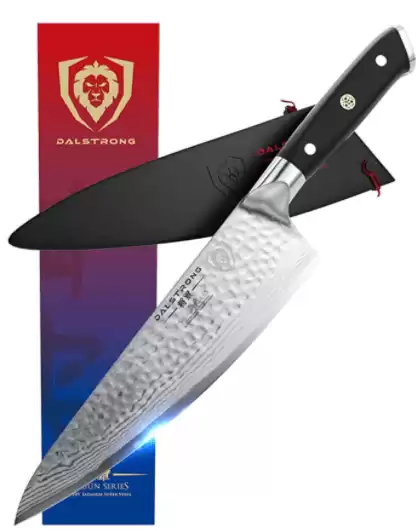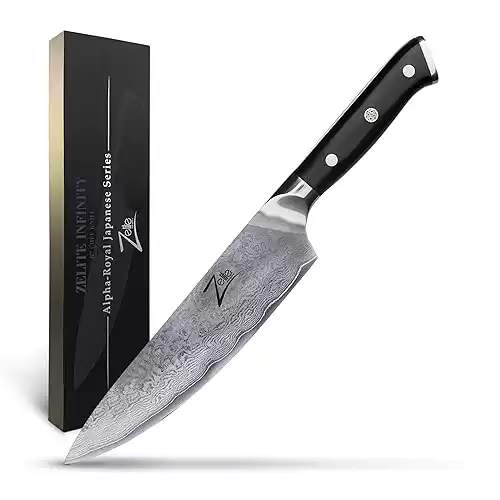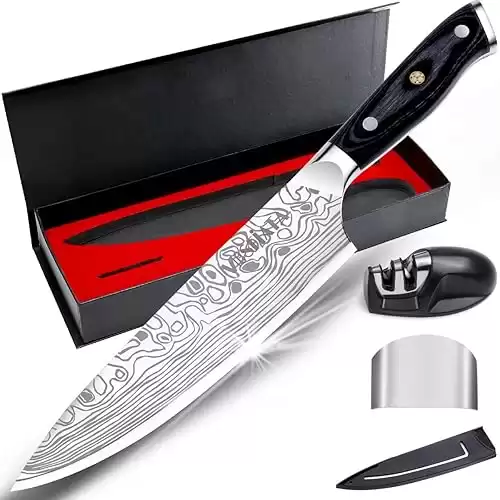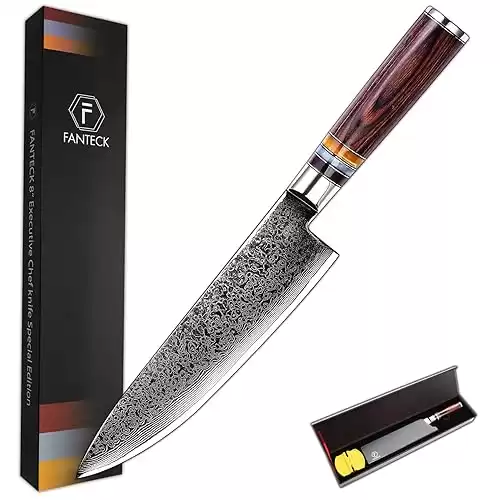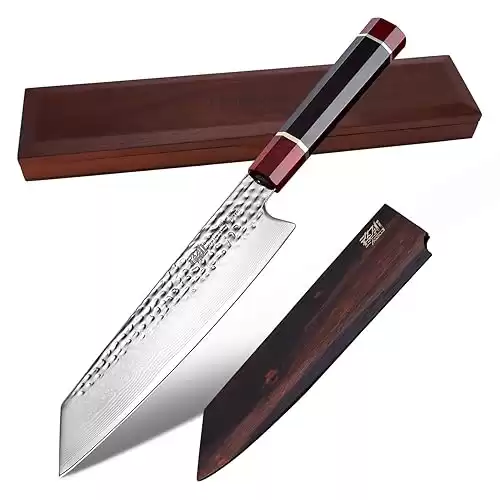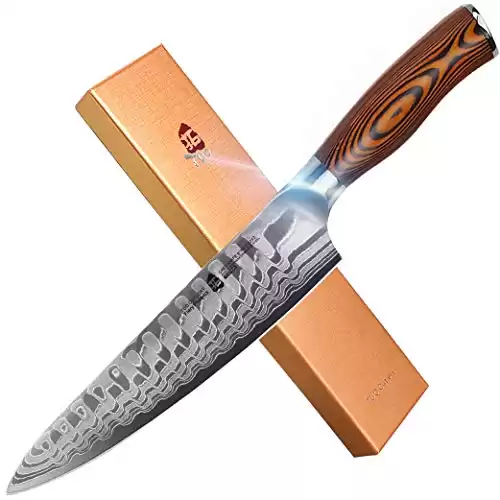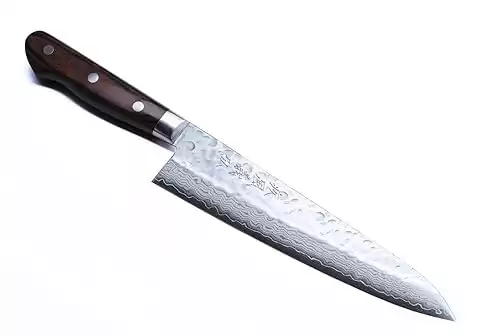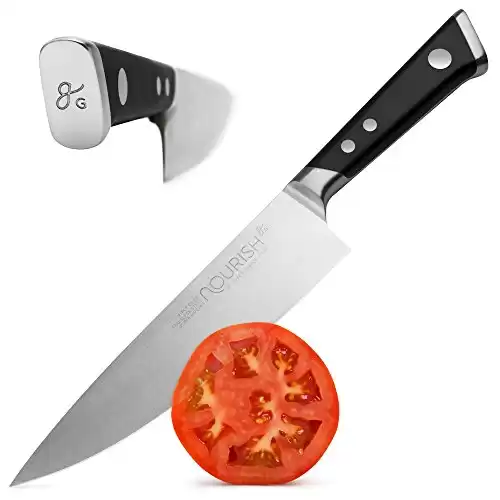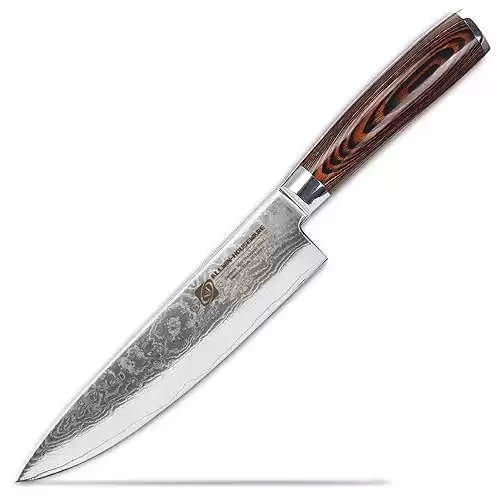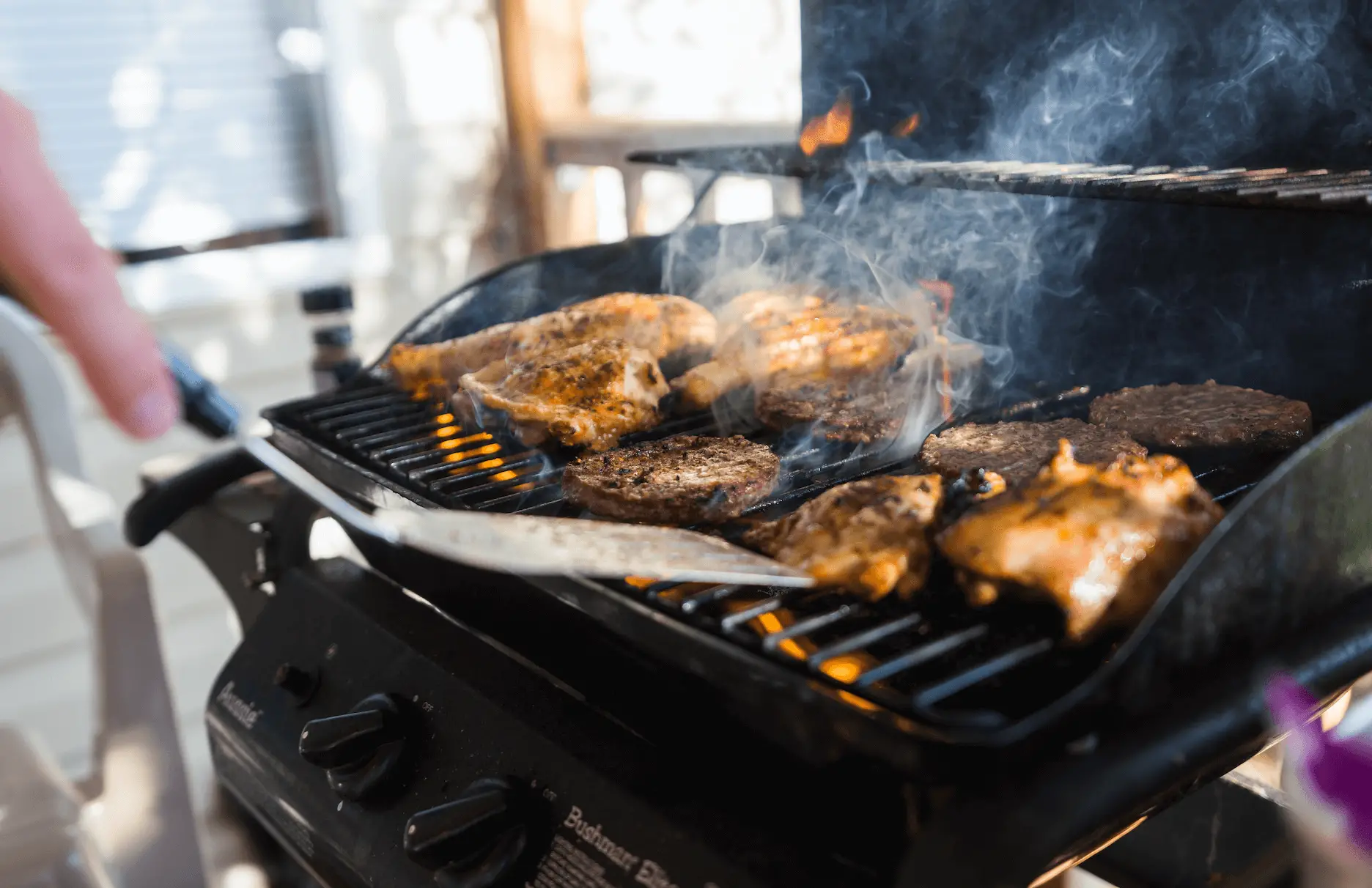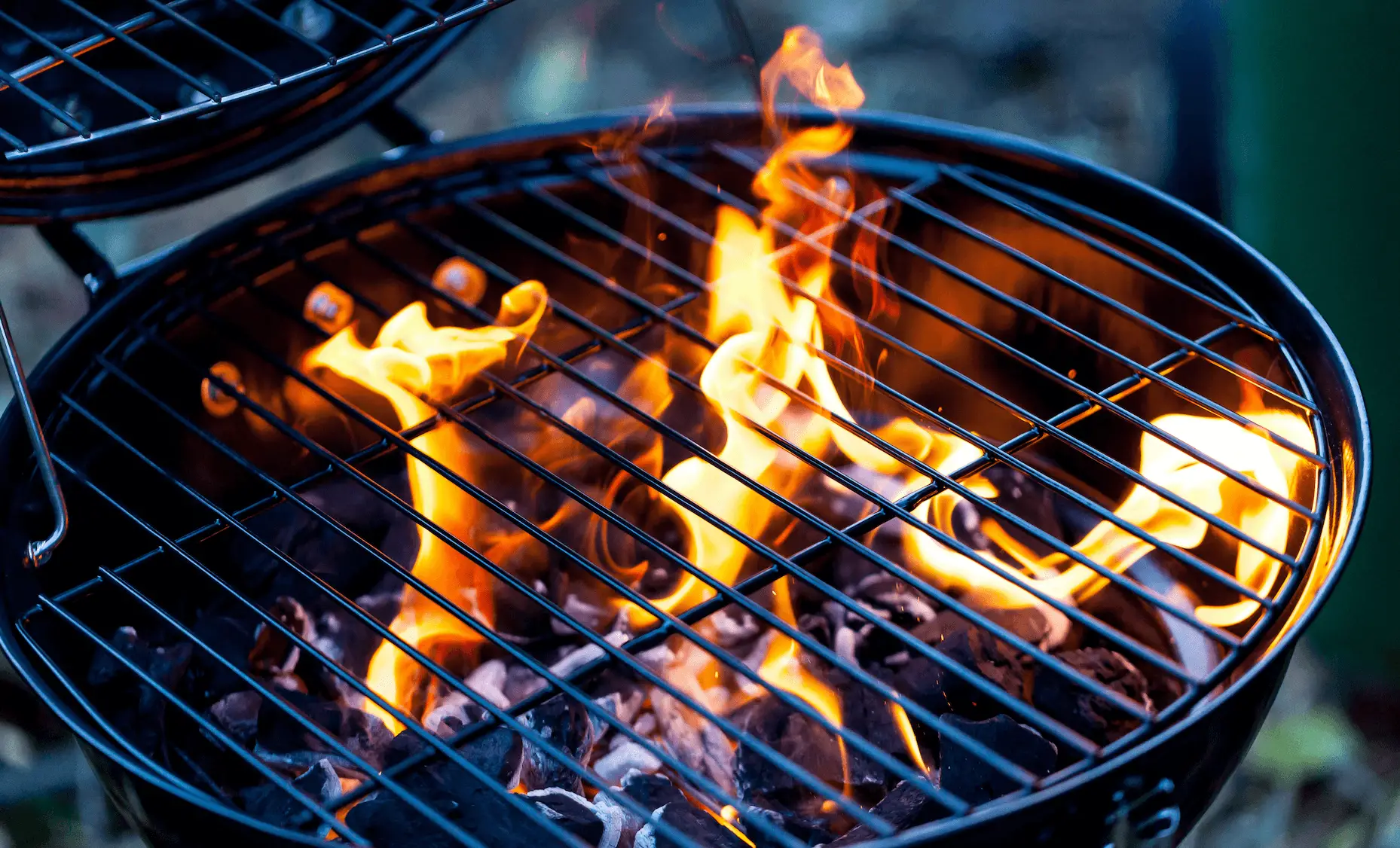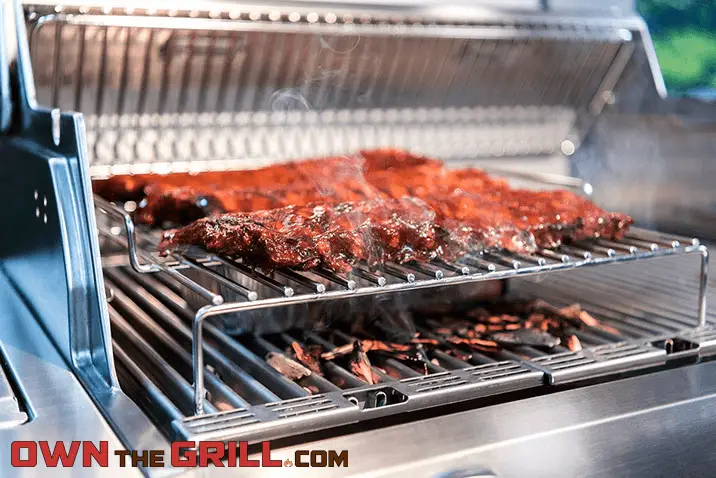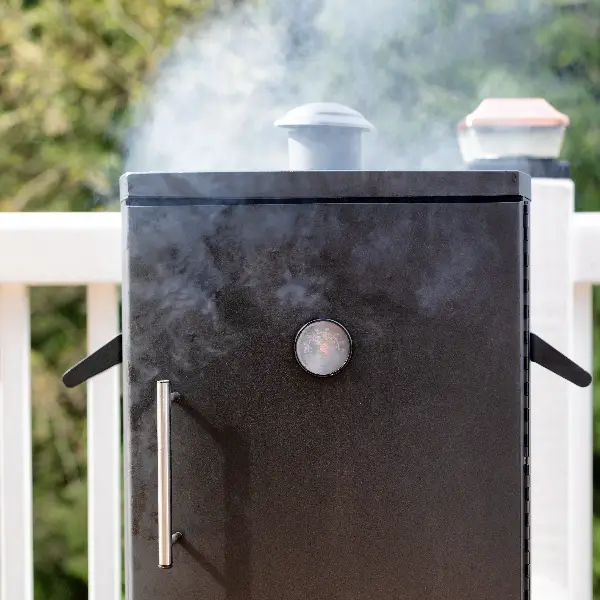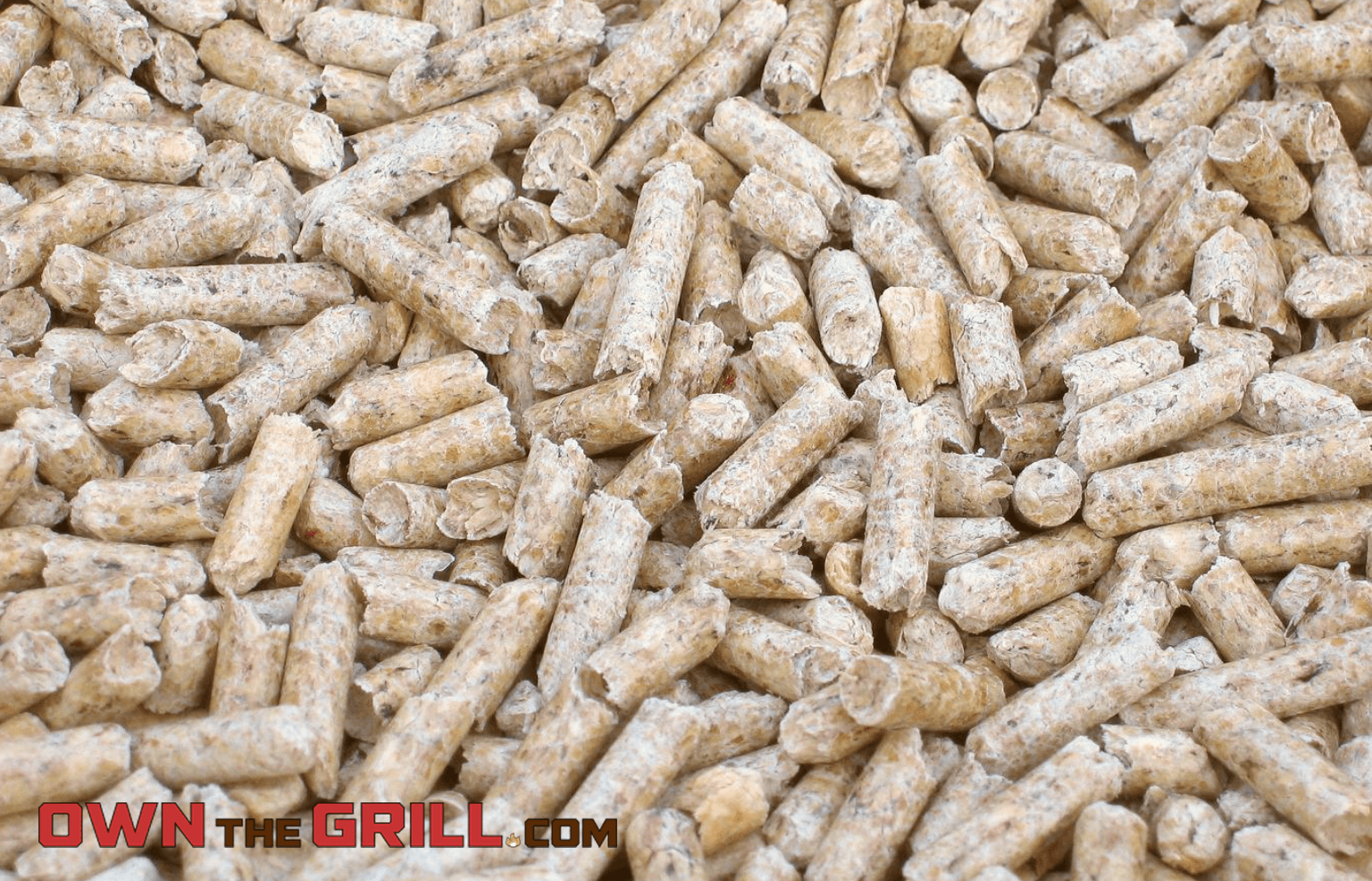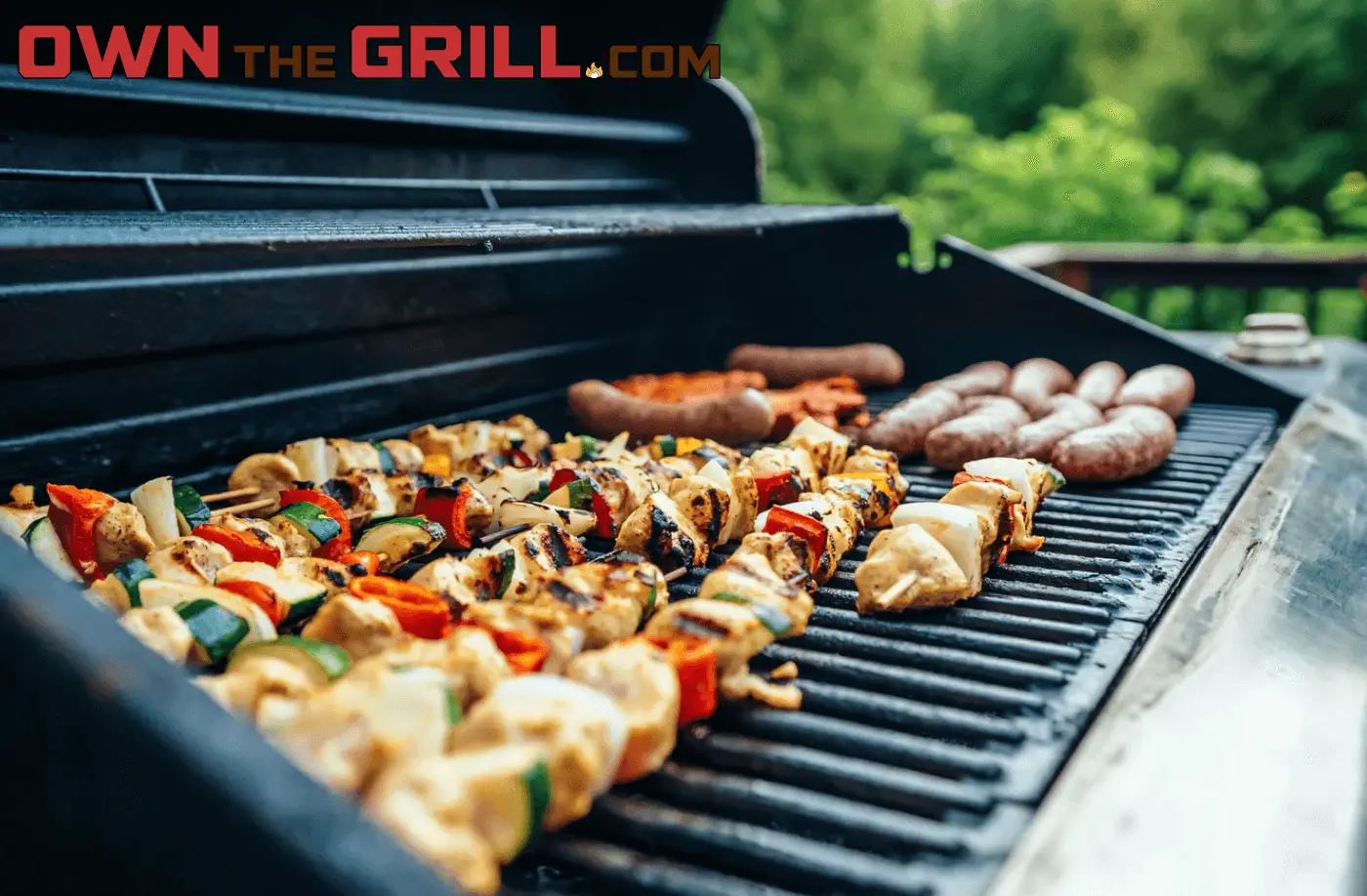This content contains affiliate links. If you make a purchase after clicking a link on this page, we might receive a commission at no cost to you.
There are several kinds of specialty knives in any kitchen. On any given day, cooks could be chopping, carving, paring, slicing, dicing, or crushing food and ingredients. That’s why there are so many types, shapes, and sizes of knives.
Chef knives top the list of grilling accessories, for their versatility and prowess. A certain material stands out in this category and lifts chef knives to the ranks of vanity knives. That’s the Damascus Steel chef knife.
Damascus steel blades have a long history behind them – they’re characterized by dazzling patterns and unmatched sharpness. These knives are also rugged, agile, and durable.
That’s why we looked for the best Damascus chef knife and rounded up the highest contenders along with it. Read on to find out our top choices along with everything you need to know about this high-tier class of cutlery.
The 10 Best Damascus Chef Knives
This list includes various sizes, shapes, and features. They were selected from a wide range of price points to suit every need and budget. Browse the listed prime-quality knives, and keep in mind why you need to buy a new chef’s knife and what you’d be using it for.
DALSTRONG Chef’s Knife – Shogun Series X
- 66 layers of high carbon steel
- Triple riveted handle is comfortable during extended use
The Dalstrong Shogun Series is among the best in its class. It’s good enough for professional chefs, and certainly suitable for domestic use as well. It’s a bit expensive though, so let’s say, it’s for the home cook who likes things in premium quality.
It has all the classic beauty of historical knives, vintage craftsmanship, and cutting-edge technology. The design is unique, it’s rugged, sturdy, and razor-sharp.
It comes in various lengths to accommodate the different user preferences. Blade lengths are 6, 7, 7.5 serrated, 8, 9.5, 10.25, and 12 inches. This is one of the broadest ranges for chef knives. It’s definitely a thoughtful gesture, and many chefs appreciate it.
Things We Like
- It’s blade is forged from 66-layered metal
- Made from high carbon steel
- Has exceptional durability
- Triple riveted handle
- 12-degree double bevel sharp blade
- Comes with a sheath
- 100% Money-back and lifetime warranty
- Dalstrong has an outstanding reputation in the community
Things We Don’t Like
- Needs wetting to work well on Sushi
- The higher end of the price spectrum (but the value is there)
Zelite Infinity Chef Knife
The Zelite Infinity easily belongs on any list of top chef knives. It’s a handcrafted, full-tang, double-bevel knife, made from 67 layered, high carbon AUS 10 steel.
It’s available in sizes ranging from 6 inches to 10 inches, with the 8-inch variety as the most popular choice. The smaller size is more suited for the domestic chef who cooks an occasional meal, while the longer variety has seasoned chefs written all over it.
It’s a versatile knife that’ll be handy for most of your culinary needs. This knife is also perfect as a gift, as it’s a high-quality item with lots of visual appeal.
Things We Like
- Well-balanced
- Rounded ergonomic handles
- Fine materials for the handle and blade
- Impeccable finish
- Extra sharp 12-degree blade
- 100% money-back guarantee
- Lifetime warranty regarding manufacturing defects
Things We Don’t Like
- A bit on the expensive side
MOSFiATA Professional Chef’s Knife
Damascus steel chef knives often have a hefty price tag attached to them, and when we see a cheap knife, we often think it’s a knock-off. it’s a rare occasion that we see a good knife at a reasonable price, and that’s the fine balance that MOSFiATA achieved.
This knife is well suited for the rough life of a restaurant and the laid back usage of a domestic kitchen. Having that in mind, the manufacturers also wrap it up in a pretty package with a velvet back gift box. It’s also a perfect gift for your favorite chef.
Things We Like
- Sturdy comfortable grip
- Triple rivet design for higher durability
- 14-16 degree hand-sharpened blade
- Resists rust, corrosion, and staining
- Dishwasher safe
- Comes with a finger guard and blade guard
- Comes with a complimentary sharpener
- Moderately priced
Things We Don’t Like
- Made from stainless steel, not high-carbon steel
- A bit heavy
FANTECK Gyuto Chef Knife
This is a moderately priced chef’s knife of remarkable quality. It has the pleasant aesthetics of vintage Damascus steel knives, plus the performance of professional knives. The handle especially catches the eye, and the blade is pretty slick looking as well.
It comes in two sizes only, the 6-inch and the 8-inch, which covers the domestic needs for practical dependable knives. All in all, the Fanteck Gyuto Chef Knife is a solid all around choice and a welcome addition to any knife repertoire.
Things We Like
- 67-layered high-carbon steel
- 10-15 degree double-bevel blade for sharp cutting
- Perfect balance
- Beautiful wooden handle
- Comfortable grip
- Comes with a mini-sharpener
- Moderately priced
- Full money-back refund if not satisfied
Things We Don’t Like
- Might need frequent sharpening
- The handle is less sturdy than expected
Findking-Prestige Series Chef Knife
This is a high-end chef’s knife crafted in the tradition of Japanese knives, including the octagonal polished wooden handle. The intricate composite is made from Sapele Mahogany, Ebony, and copper spacers to link the two types of valuable materials.
Even though this 9-inch Prestige looks like a vanity knife, it’s actually made for heavy utilization. It was nicknamed ‘The Beast’ by many pros who saw its capabilities first hand. The larger 10.5-inch variety is also available, in two slightly different designs.
Things We Like
- It’s a blade-heavy knife for tough cutting
- Has a hardness factor of 60
- Double-beveled extra sharp blade
- Comes with an Ebony cover lined with felt
- Comes with an elegant wooden box
Things We Don’t Like
- It’s an expensive knife
- Not suited for domestic use
TUO Damascus Chef’s Knife
This knife aims for the high-end status but presents itself at a slightly more competitive price. It’s thus made itself available for the pros and the domestic connoisseurs.
The handle, blade, and packaging reveal its pedigree at a glance. But after a bit of usage, you’d also discover its capabilities.
Things We Like
- Exceptional visual appeal
- Ergonomic handle
- Well-balanced
- 67-layered high carbon steel
- Has an extra rust-resistant layer
- Dishwasher safe
- Durable and sturdy
- Money-back guarantee
Things We Don’t Like
- Prone to chipping and bending
Yoshihiro Damascus Gyuto Japanese Chefs Knife
An authentic vintage Japanese knife crafted for top performance. It naturally comes at an elevated price as well, but it’s worth every penny.
Its straight blade is a full-tang, thus giving the benefits of swift cutting, together with the sturdiness of an extended blade. It’s an all-round useful chef’s knife that can be utilized for every cutting requirement.
Things We Like
- Exceptional good looks
- Handcrafted in Japan
- Sharp edge with HRC 60
- Minimal friction around the blade
- Food doesn’t stick while cutting
Things We Don’t Like
- Needs plenty of care and maintenance
- Hand-washing only
- Special sharpening requirements
Greater Goods Chef’s Knife
This is an average looking knife, with above average qualities. It’s great for a chef who’s just starting out, or a homeowner who likes to use dependable tools.
It’s a full-tang, well balanced, and sturdy knife that’ll serve you well.
Things We Like
- Versatile and easy to use
- Ergonomic minimalist handle
- 15 degree double-bevel blade
- Fair price relevant to real value
- Sales returns contribute to charities
Things We Don’t Like
- Not a premium-quality knife
- Doesn’t come with a warranty
ALLWIN HOUSEWARE Professional Damascus Chefs Knife
This is another budget-buy chef’s knife. The ALLWIN knife looks amazing, and does a wonderful job at the domestic kitchen. It might not be well suited for rough handling though, so we wouldn’t recommend it for the veterans.
Being priced below the $50, plus the fact that it’s gorgeous, and comes with a gift box, automatically translates to its readiness to be given as a nice birthday present, or as a thoughtful thanksgiving gift.
Things We Like
- Circular PAKKA wooden handle
- High hardness factor of HRC 62 Rockwell
- Handmade with unique craftsmanship
- Comes with a gift box
- Budget-friendly
Things We Don’t Like
- Inconsistent quality-control, items occasionally defective
Everything You Need to Know About Damascus Chef Knives
Here’s the full scoop on these unique knives. This is all the information you need to select the best Damascus steel chef’s knife.
What Is Damascus Steel?
This type of steel forging dates back to pre-industrial times, unlike most modern works. Damascus steel became famous in the East where the steel came from India and it was processed in Syria.
Damascus steel has distinctive patterns that look like agitated waters in a pond. Which added more and more to its mystique. Only a few people knew how it was made, and even today, it’s a precious metal.
The method used was a guarded secret, as the best swords were made using that metal. They were reputed for being extremely hard, flexible, and sharp. A mix of characteristics rarely found in any other metal.
Around 1900 the forging method went to oblivion. But the Japanese picked up a similar process and used it to make utility and vanity knives.
Do You Need a Damascus Chef Knife?
Whether you’re a pro working in a fine restaurant or a home cook who appreciates the finer things, a Damascus Chef knife should be a part of your cooking ware. There’s more than one reason why you should consider owning a knife like that. Here are a few of them.
It’s a Versatile Knife
The usage of a Damascus knife easily goes beyond the kitchen table to a campsite, a fishing trip, a hunting trip, or a boating excursion.
The characteristics of steel forging to make a Damascus Knife render it some unique properties, unlike most regular knives. Don’t be afraid to cut various edibles with that knife, and take it with you anywhere that good food is cooked and served.
It’s Sharp and Accurate
The historic usage of Damascus steel to make swords and other weapons testifies to the sharpness of this material. Slice a ripe tomato with them, and you’ll see from the membrane thickness how sharp the blade is.
From cutting a tomato, move on to a cucumber, then try to dice a fresh onion. These quick drills show off the prowess of the Damascus steel blade sufficiently. But if you want more, grab a piece of paper and slash it in the air with that knife. It usually tears up neatly and finely.
These knives don’t need frequent sharpening to work well. But of course, if you’re a busy chef in a restaurant it would need some care and attention from you.
The sharpening process doesn’t require soliciting professional services, but if you know a good place to sharpen these valuable knives, by all means, get the best care for your tools. In restaurants, a whetstone is always around, and for domestic usage, a home knife sharpener is often sufficient.
It’s a Sturdy Tool
The tip and blade of a chef’s knife are often prone to breaking, bending, and denting. Rough handling is never recommended with any knife, but some are sturdier than others. Forging steel through the Damascus process gives it unparalleled strength and agility.
It’s Durable and Rugged
Some knives are bought with the full knowledge that they’d be around for a year or two max. They look good, feel good in the hand, and they seem like a savvy purchase. But they are rather disposable items that soon become a memory.
A Damascus Steel knife is known to last for several generations, without showing exhaustion or fatigue.
It’s Aesthetically Pleasing
The incredible patterns left on a Damascus steel blade are the result of a meticulous forging process, involving the addition of several other metals and organic ingredients. The heat treatment of steel also contributes to the unique markings.
These watery swirl marks are as special as a fingerprint. No two knives are ever the same.
The visual appeal of any object you use on a daily basis isn’t just for show. You might have noticed that your performance is noticeably better when you’re using tools that look good. Humans and animals alike are drawn to things that satisfy their senses. In the food business, this goes without saying.
It’s a Premium Quality Valuable Knife
Buying a sturdy tool, that’ll stay in your kitchen for years and serve you well is a wise choice. When that is paired with inherent beauty, historic value, and versatility, this becomes a sound investment, rather than acquiring one more tool.
What Are the Cons of Buying a Damascus Steel Chef’s Knife?
We’ve just mentioned a bunch of pro-points and good reasons why anyone should want to have a Damascus Knife. But are there any downsides to these knives? A few!
They Could Stain and Rust
To achieve the sharpness, agility, and strength known to the Damascus steel knife, forgers had to forego corrosion-resistance and susceptibility to rust. Stainless steel avoids these inconveniences, but its performance doesn’t even come close to that of Damascus steel.
That’s why care should be taken in washing these knives. Mild detergents should be used, and the metal should be thoroughly dried after each use. It’s also not recommended at all to leave a used knife on the cutting board, in the middle of wet vegetables, for a long time. Just keep it clean and dry.
Damascus steel is also prone to developing a ‘patina’, or a stain. This comes from interacting with the various food materials, and the kitchen environment in general. Many chefs consider this a part of the Damascus knife’s charm and are very reluctant to give it a polish.
They Are More Expensive Than Their Peers
Damascus steel knives aren’t treated like regular commercial knives. They’re often packaged and sold as vanity products, worth a bit more cash.
The inherent value, aesthetic appeal, and special properties make the high price tag seem reasonable. And most chefs feel that they get their money’s worth when they use such premium-quality knives.
If you’re looking for a budget knife, check out our list of the best chef knives under $100.
A French, German, or Japanese Chef’s Knife?
There are three basic variations in chef’s knives. The Western types look quite similar, but if you look closely at the blade, you’ll see some vital differences. The handles differ slightly too, but that’s not a major consideration.
The Japanese knife is often referred to as a Santoku knife, and it’s applied and fashioned in a manner quite similar to the Western-style Chef’s knife.
German Chef’s Knife
The blade of a German Chef’s knife is often curved throughout its length. This allows for a rocking motion customarily seen while chopping vegetables en masse. It’s usually a full-tang knife, with the grips riveted-in.
The shape of the German Chef’s knife makes it highly versatile. It’s probably the best in processing, cleaning, and slicing meat. In addition to its superior speed in preparing vegetables in all sorts of cutting requirements, from crushing, to fine slicing, all the way to fruit carving.
French Chef’s Knife
Here the blade has a slanting straight edge and starts to show some curvature close to the tip. The rocking action is still possible, but the knife would have to rest close to its extreme front to achieve a good chop.
The cutting style and hand techniques differ noticeably while using this knife. And if a chef is used to the German styled blade, he might need a bit of time to get used to the French one. The pros are of course well versed in both, but they’d admit to having preferences.
These knives are also full-tang, with riveted grips, often made from wood. The natural grain of wood adds aesthetic appeal, and that’s something the French would never forego.
The practical straightforward shape of the blade gives confidence and control to the chef. It’s not as heavy-handed as the German knife, so it wouldn’t do much macho work. But it’s still sturdy and gets the job done with ease and accuracy.
Japanese Chef’s Knife
A Japanese, or Santoku knife, has a blade that’s straight on the lower side, and curves down on the upper side, which is pretty much the opposite of the German knife. It’s also thinner, lighter, and more agile than the Western knives.
It’s traditionally a half-tang with an octagonal grip made from wood. A modern feature that characterizes Santoku knives, is the row of small indentations right above the blade. These are supposed to prevent the chopped materials from sticking to the blade.
While the usage of Western and Eastern knives are similar, and they’re all multipurpose knives, the cutting technique of the Japanese knife stands out. Western knives are moved back and forth in a slicing movement, while a Santoku knife is in a vertical chopping motion.
This knife is swift and sharp, but it’s a bit needy. Sharpening a Santoku knife needs skill, and that limits its domestic usage a bit. Its blade is also a bit sensitive, so it shouldn’t be dropped, handled roughly, or used on a rigid cutting board.
How to Choose the Right Damascus Chef Knife?
Some of these knives cross the $100 mark, and you can easily find knives five times that amount in the market. It’s not exactly light spending, so a bit of planning and wise selection is in order.
The most important factor is to think about your normal usage, cutting style, and the reason why you need a new knife. Browse through the knives in the review, and as you try to make a final decision, consider the following points as well.
Hardness
The hardness of steel is determined by the carbon content, heat treatment, and the presence of other metals in the steel alloy.
A harder type of steel would retain its sharpness for a long time. You wouldn’t need to maintain it that frequently. It’s not surprising that most Japanese knives are in that category, as their chopping profiles need to be stellar.
The downside to hard knives is that they are brittle. If they’re dropped, the tip is likely to chip-off. And if they take a hit, and the blade bends, chances are, it’ll stay that way.
Softer steel makes shinier knives that need frequent sharpening. But they take bending and dropping in stride. The German Wusthof chef’s knife is a good example of that, and that’s one of its main attractions.
Blade Shape
This is a matter of personal styling, with a bit of functionality. Every chef seems to prefer one of two types: the rounded belly or the straight edge.
German knives have more of a rounded belly profile, and it goes with the rocking motion many cooks prefer.
The French and Japanese knives have flatter straight blades. The movement tends to be vertical chopping, or angled slicing. The French knives have a slight curve near the tip, which allows for a rocking movement, similar to that of a German knife.
Blade Thickness
Japanese knives are often much thinner than Western knives. While this lets them be lightweight and swift, it also makes them less aggressive with harder ingredients. If there’s some bone in the meat, the thin blade would struggle a bit more than a thick one.
The lighter weight helps when you’re slicing all day. It doesn’t pose an extra load on the hands, wrists and elbow. But at the same time, this isn’t always considered a pro point. A little bit of weight in the tool you’re holding helps in applying extra force on the stuff you’re cutting.
This situation is a lot like picking tennis rackets. The very light ones are easy on the arms and joints, but they lack a smacking punch. The heavy ones are harder to carry and move all day, but once they hit the ball, it flies off like a bullet.
Thinner knives are especially good at fine slicing. If you’re into decorative-presentation, a thin knife is definitely going to be better than a thick one. The same goes for Sushi preparation, where the precision of the cut matters.
If you’re a frequent at home brisket smoker, check out our article on the best knives for slicing and trimming brisket.
Single-Bevel and Double-Bevel Blades
The bevel is the sharp slant at the extreme edge of the blade. Some knives are sharp on one side and blunt on the other, while most knives are sharpened like a ‘V’, with a symmetric sharpness on both sides.
Single Bevel
A single-bevel knife cuts fine slices of meat and vegetables, without having these food materials sticking to the blade. This neat cutting is essential while preparing Sushi or similar Asian cuisine delicacies.
A Sashimi knife is the perfect example of a single blade knife. These tools are great, but they need extra training. They also require a higher level of care as they’re more delicate than their double bevel counterparts.
Single-bevel knives also have a lefthand or righthand orientation. The side of the knife that gets the sharp edge should be on the outside relative to the cutting. That’s why you should also specify the left/right orientation if you opt for this type of chef knife. The handedness of these knives extends to the handle and grip as well.
You should also be aware of the slight slant in the cut that comes with single-bevel blades. Either you adapt your cutting direction to get a straight cut, accept the curved cuts as decorative, or opt for a double-beveled blade. These symmetric knives cut exemplary slices.
Double Bevel
Double-beveled knives are easier to work with and do not have any orientation issues. They’re also easier to sharpen, which is a big plus. On top of that, they’re more robust than the thinner single-bevel blades.
Blade Length
If you have a large cutting board, and plenty of food to prepare, then a 10-inch knife would be a proper tool. Most chefs have more limited space and less food materials to chop through at any given moment. That’s why the 8-inch knives are far more popular.
The extra length of the blade could save much time, as it chops through a wider alignment of vegetables. If the food that’s waiting to be cut isn’t that plentiful, the larger knife wouldn’t just be an excess, it would be unnecessarily extra weight. More blade length also means more metal mass.
The smaller 6-inch knife comes in pretty handy as you chop off finer materials, or if you need more control. Sometimes, the tip of the knife feels too far away from the grip. With the shorter blade length, you get to control where the tip is headed and what exactly it should do.
For home usage a 6-inch or 8-inch knife is ideal. It’ll get the job done neatly and nicely. There’s an added bonus too, that they come at a more moderate price than the longer 10-inch ones.
Handle and Tang Design
Knives either have a half/hidden-tang or a full-tang. The hidden tang is an extended part of the blade that tapers into the handle and is glued in there. The full tang is a continuation of the blade, with the full length of the knife, into a pair of riveted handle parts.
The full-tang knife has plenty more metal in the handle, which tends to place the weight of the knife backward. The half-tang leans forward.
The handle of a half-tang is often decorative, with octagonal wooden grips. It’s not really designed for heavy lifting, and the knife is often used for delicate slicing. A full-tang is a robust knife that’s capable of tough cutting.
The handles are made from various materials, from the decorative wood with its vintage look, to the neo-plastics that are easier to clean and maintain. The shapes are also varied to suit all handling styles and preferences.
Balance
Hold any knife in your hands and move it around. Mimic the cutting and slicing motions. You’d feel instantly that some knives ‘feel’ right, while others tend to need a bit of weight compensation.
A knife that leans too much backward needs an extra balancing effort to keep it looking forward and down. The opposite is also true for a knife that has most of its weight at the front end. You’d constantly need to pull it down around the handle.
A well-balanced knife doesn’t demand that kind of effort on your side. It sits correctly and lets you focus on the work at hand. Blade-heavy and handle-heavy aren’t all wrong by the way, they both have their uses and enthusiasts.
Some Tips to Keep a Damascus Chef Knife in Good Shape
Here are some pro tips to extend the longevity of your prime-quality knives.
- Use a wooden board, skip the fancy-schmancy glass, bamboo, and Korean.
- Avoid using a dishwasher to clean these knives.
- Don’t leave the knife in the sink.
- Use a soft brush and mild soap to clean all the parts of the knife.
- Always keep your knives dry.
- Stay organized and put your tools where they belong.
- Store your knife in a wooden block.
- Alternatively, use a magnetic strip. Make sure it’s in a safe place.
- Never leave your knives in a crowded drawer.
- Use a good-quality whetstone or knife sharpener to get the blade in shape.
- Don’t scrape the food on the cutting board with the blade.
- Avoid bending and banging the blade.
- Don’t put extra pressure on the spine, place your fingers correctly.
- Value your knives and generally take care of them
Final Thoughts
A Damascus steel chef’s knife is a work of art that you get to use on a daily basis. The top of the list is easily the Zelite or Dalstrong. It’s the epitome of these knives, and if you invest in one of them, expect it to remain in the family for many generations to come.
Beginner chefs and homeowners who cook occasionally might opt for a less expensive knife. In that case, the ALLWIN HOUSEWARE Professional Damascus Chefs Knife. It’s not made for the rough stuff, but otherwise, it’s versatile and easy to use. It’s also gorgeous to look at.
Whichever knife you choose, the whole list is full of gems. Just make sure to take good care of them, and appreciate their true value.


